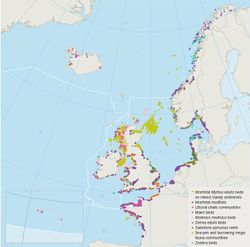Biogenic reefs of Europe and temporal variability
European-scale distribution of biogenic reefs
Biogenic reefs can be described as hard compact structures created by the activity of living organisms. They do not share a uniform structure and are found at variable spatial scales. Dense colonies of several species are widely considered to be reef in Europe. Only four of these species are described in this report due to their contribution to sediment entrainment, bed stability and potential wave energy attenuation, these are: Sabellaria alveolata, Sabellaria spinulosa, Modiolus modiolus and Mytilus edulis. Many biogenic reef habitats are currently threatened and/or are in decline in Europe as a result of various natural and anthropogenic pressures (OSPAR 2010 [1]). Figure 1 illustrates the distribution of some biogenic reef habitats which are currently in decline around the coast of Europe.
Sabellaria spinulosa
EUNIS code A4.22 and A5.611
Sabellaria spinulosa reefs are known from all European coasts, except the Baltic and the waters of the Kattegat and Skagerrak, but are typically limited to areas with very high levels of suspended sediment (OSPAR 2010 [1], Fig. 2.20). In the UK aggregations of S. spinulosa are reported to occur at a number of locations around the British Isles (Holt et al., 1998 [2]; Davies et al.,2009[3]). Perhaps the best known example of an S. spinulosa reef in the UK is found in the mouth of the Wash (east coast of England), where reefs are elevated above the seafloor and have been found to extend over hundreds of square meters within the Norfolk Coast SAC (Foster‐Smith & Hendrick 2003[4]). Relatively few records have been found in Scotland (Figure 1). Not all of these aggregations could be described as “reefs”, for instance where the species may only form superficial crusts on mixed substrata. On the German coast, intertidal and subtidal reefs have been reported from the Wadden Sea (Berghahn & Vorberg, 1993[5]) and from the southern North Sea where Linke (1951)[6] reported reefs up to 60 cm thick, 8m wide and 60 m long. S. spinulosa has also been reported from the French coast, but without precise locations (Holt et al., 1998 [2]).
Sabellaria alveolata
EUNIS code A2.711
The records of Sabellaria alveolata throughout Europe are greater in northern latitudes (Fig.2.21). This is an obvious artifact of data reporting to OBIS as S. alveolata has been reported to be widely distributed in the France, Spain and Portugal and extends as far south as Morocco (Gruet 1982[7]; Cunningham et al., 1984[8]). It reaches its northern limits in Britain but is restricted to the warmer waters off the west coast as growth is inhibited below 5°C (Crisp 1964). The current confirmed northern limit is the Dumfriesshire coast of SW Scotland with records needing confirmation from the Firth of Clyde and Outer Hebrides. This species builds the largest reefs on the European coast; in particular the “Les Hermelles” reef in the Saint-Michael Bay in France is over 100 ha and is considered the largest reef in Europe (Gruet 1982[7]; Marchand & Cazoulat 2003 [9]).
Intertidal Mytilus edulis
EUNIS Code: A2.7211 and A2.7212
The distribution of Mytilus edulis is circumpolar in boreal and temperate waters, in both the southern and northern hemispheres extending from the Arctic to the Mediterranean in the north‐east Atlantic (Soot‐Ryen 1955[10]). The majority of intertidal beds are found in the Wadden Sea (Netherlands, Germany and Denmark where a 2007 inventory reported an estimated coverage of 1865 hectares in the Dutch sector (Goudswaard et al., 2007). It is also present in British coastal waters, Ireland (Jones et al., 2000) and there is a large bed (covering approximately 200 ha) in southern Brittany in France (Rollet et al., 2005).
Examples
based on
References
- ↑ 1.0 1.1 OSPAR, 2010. Quality Status Report 2010. OSPAR Commission. London. 176 pp. Available from: [1]
- ↑ 2.0 2.1 HOLT T.J., REES E.I., HAWKINS, S.J., SEED, R., 1998. Biogenic Reefs (volume IX). An overview of dynamic and sensitivity characteristics for conservation management of marine SACs. Scottish Association for Marine Science (UK Marine SACs Project). 170 pp. Available from: [2]
- ↑ DAVIES A.J., LAST K.S., ATTARD K., HENDRICK V.J., 2009. Maintaining turbidity and current flow in laboratory aquarium studies, a case study using Sabellaria spinulosa. Journal of Experimental Marine Biology and Ecology '370: 35-40.
- ↑ FOSTER‐SMITH R.L., HENDRICK V.J., 2003. Sabellaria spinulosa reef in The Wash and North Norfolk cSAC and its approaches: Part III, Summary of knowledge, recommended monitoring strategies and outstanding research requirements. English Nature Research Reports Number 543.
- ↑ BERGHAHN R., VORBERG R., 1993. Effects of the shrimp fisheries in the Wadden Sea. In: Influence of fisheries upon Marine Ecosystems. Einfluss Der Fischerei Auf Marine Oekosysteme Lukowicz, M., 103-126.
- ↑ LINKE O., 1951. Neue Beobachtungen uber Sandkorallen‐Riffe in der Nordsee, Natur u. Volk., 81, 77‐84.
- ↑ 7.0 7.1 GRUET Y., 1982. Recherches sur l’écologie des récifs d’Hermelles édicés par l’Annélide Polychète Sabellaria alveolata (Linné), Université des Sciences et Techniques, Nantes, France. PhD
- ↑ CUNNINGHAM P.N., HAWKINS S.J., JONES H.D., BURROWS M.T., 1984. The geographical distribution of Sabellaria alveolata (L.) in England, Wales and Scotland, with investigations into the community structure of, and the effects of trampling on Sabellaria alveolata colonies. Report to the Nature Conservancy Council from the Department of Zoology, Manchester University, Manchester. NCC report No. HF3/11/22.
- ↑ MARCHAND Y., CAZOULAT R., 2003. Biological reef survey using spot satellite data classification by cellular automata method ‐Bay of Mont Saint‐Michel (France). Computers & Geosciences. "29": 413‐421.
- ↑ SOOT‐RYEN T., 1955. A report on the family Mytilidae. Allan Hancock Pacific Expedition, 20': 1-154.
